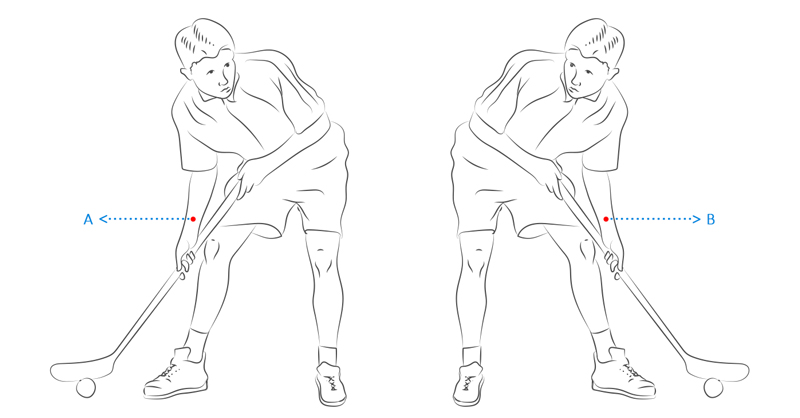Choosing a Floorball Stick
A floorball stick should approximately reach your belly button. It is important to choose the right length of the floorball stick to efficiently manipulate the ball. If a stick is too long, manipulation with the ball and shooting can be more difficult. A stick too short makes a small action radius and creates a danger of back injury.
Components of the floorball stick
- Shaft is the longest part of the stick with half of the surface wrapped in grip and ends right above the blade. The shafts parameters, according to which the stick is chosen, are hardness and length.
- The blade is the part at the end of the stick and it has a right or left curvature. In our catalogue you will also find floorball sticks with straight blade. These are designed for children who are just starting to play floorball.
- The grip is the non-slip part that also has the property of absorbing sweat. The better the grip the less hands slip on the stick. This part deteriorates the fastest, but can be easily changed.

How to hold the stick
The first thing we need to determine before choosing a floorball stick is which side we are going to hold it on. We need to be aware of the fact that not every left-handed player will need a stick with the blade bent to the right. The side of the bend is determined by the hand holding the stick at the bottom - e.g. if our right hand is below, then we need a stick with the blade bent to the left and vice versa.
It is very difficult to determine the side of the blade bend when it comes to floorball sticks for children. You can for example give them a broom and see how they hold it. They grasp it instinctively the right way and we can determine what stick they need. In our catalogue you will also find straight-bladed sticks that are suitable for the youngest children.

A - open to the right B - open to the left
The length of the stick
The second important parameter when choosing is the correct length of the stick. A stick that is too long makes ball control and shooting more difficult because it is further away from the body. On the other hand, the too short stick makes reaching the ball very difficult during defense and makes movements during running and handling the ball unnatural. In extreme conditions it can overstretch the back muscles and cause injuries.
| Player's height (cm) | Length of the stick (cm) |
| 100 - 110 |
55, 60 |
| 110 - 125 | 60, 65, 67 |
| 125 - 130 | 70, 72 |
| 130 - 135 | 75, 77 |
| 135 - 150 | 80, 82, 85 |
| 150 - 160 | 85, 87, 89 |
| 160 - 170 | 89, 90, 92 |
| 170 - 180 | 95, 96 |
| 180 - 190 | 98, 99, 100, 101 |
| 190 + | 102 and longer |
Stick Stiffness
The next criterion is the stiffness of the stick, or more precisely its flex. It is shown in millimetres to which the stick bends under a load of 300 N, i.e. 30 kg. The stiffness is found in the name of all the sticks you can find in our catalogue. This helps everyone to understand at a glance what the bending strength of each stick is.
A stick that is too stiff doesn't bend and doesn't help us while shooting. The ball bounces off it and not only the shooting but also the passing becomes inaccurate. Too soft sticks bend excessively during shooting and passing and make ball control more difficult.
Floorball sticks are divided into 3 categories according to their stiffness:
- Soft (32 mm and above) - bends more, ideal for players who have perfected proper technique and shoot with a light stroke. We also recommend these sticks to beginners and children.
- Medium (27-31 mm) - versatile sticks that are most often chosen by advanced players, who play regularly.
- Hard (23-26 mm) - sticks that hardly bend. They are ideal for aggressive players, who shoot with swing.

Choice of stiffness according to categories
- men: 23-29 mm
- women and juniors: 29-34 mm
- adolescents and children: 32-36(40) mm
- athletes: 23-27 mm
- amateurs: 29-36(40) mm
Stick stiffness according to player's weight
- 0-50 kg - 32-40 mm
- 50-60 kg - 30-32 mm
- 60-75 kg - 27-30 mm
- 75-90 kg - 25-27 mm
- over 90 kg - 23-25 mm
